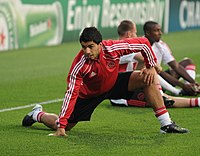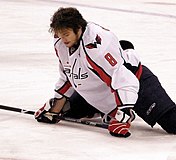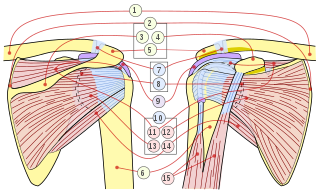
The rotator cuff is a group of muscles and their tendons that act to stabilize the human shoulder and allow for its extensive range of motion. Of the seven scapulohumeral muscles, four make up the rotator cuff. The four muscles are:

A sprain is a soft tissue injury of the ligaments within a joint, often caused by a sudden movement abruptly forcing the joint to exceed its functional range of motion. Ligaments are tough, inelastic fibers made of collagen that connect two or more bones to form a joint and are important for joint stability and proprioception, which is the body's sense of limb position and movement. Sprains may be mild, moderate, or severe, with the latter two classes involving some degree of tearing of the ligament. Sprains can occur at any joint but most commonly occur in the ankle, knee, or wrist. An equivalent injury to a muscle or tendon is known as a strain.
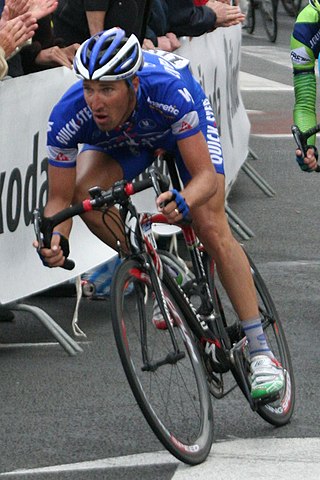
Exercise physiology is the physiology of physical exercise. It is one of the allied health professions, and involves the study of the acute responses and chronic adaptations to exercise. Exercise physiologists are the highest qualified exercise professionals and utilise education, lifestyle intervention and specific forms of exercise to rehabilitate and manage acute and chronic injuries and conditions.
Delayed onset muscle soreness (DOMS) is the pain and stiffness felt in muscles after unaccustomed or strenuous exercise. The soreness is felt most strongly 24 to 72 hours after the exercise. It is thought to be caused by eccentric (lengthening) exercise, which causes small-scale damage (microtrauma) to the muscle fibers. After such exercise, the muscle adapts rapidly to prevent muscle damage, and thereby soreness, if the exercise is repeated.

'Warming up' is a part of stretching and preparation for physical exertion or a performance by exercising or practicing gently beforehand, usually undertaken before a performance or practice. Athletes, singers, actors and others warm up before stressing their muscles. It is widely believed to prepare the muscles for vigorous actions and to prevent muscle cramps and injury due to overexertion.
Cryotherapy, sometimes known as cold therapy, is the local or general use of low temperatures in medical therapy. Cryotherapy may be used to treat a variety of tissue lesions. The most prominent use of the term refers to the surgical treatment, specifically known as cryosurgery or cryoablation. Cryosurgery is the application of extremely low temperatures to destroy abnormal or diseased tissue and is used most commonly to treat skin conditions.
Overtraining occurs when a person exceeds their body's ability to recover from strenuous exercise. Overtraining can be described as a point where a person may have a decrease in performance and plateauing as a result of failure to consistently perform at a certain level or training load; a load which exceeds their recovery capacity. People who are overtrained cease making progress, and can even begin to lose strength and fitness. Overtraining is also known as chronic fatigue, burnout and overstress in athletes. It is suggested that there are different variations of overtraining, firstly monotonous program over training suggest that repetition of the same movement such as certain weight lifting and baseball batting can cause performance plateau due to an adaption of the central nervous system which results from a lack of stimulation. A second example of overtraining is described as chronic overwork type training where the subject may be training with too high intensity or high volume and not allowing sufficient recovery time for the body. Up to 10% of elite endurance athletes and 10% of American college swimmers are affected by overtraining syndrome.

Strength training, also known as weight training or resistance training, involves the performance of physical exercises that are designed to improve strength and endurance. It is often associated with the lifting of weights. It can also incorporate a variety of training techniques such as bodyweight exercises, isometrics, and plyometrics.
Manual therapy, or manipulative therapy, is a physical treatment primarily used by physical therapists, occupational therapists to treat musculoskeletal pain and disability; it mostly includes kneading and manipulation of muscles, joint mobilization and joint manipulation. It is also used by Rolfers, massage therapists, athletic trainers, osteopaths, and physicians.

Cooling down is the transition from intense physical activity to a more typical activity level. Depending on the intensity of the exercise, cooling down after a workout method, such as intense weightlifting, can involve a slow jog or walk.
Range of motion (ROM) is when a person has become injured in some way, most times the doctor's advice the patients to exercise and stretch the back muscles. For this purpose a form of exercises called range of motion exercises which are used to keep the muscles and joints in the patients back strong and flexible. These exercises can be done by the patient himself, or with a physical therapist. If these exercises are done alone they would be called active range of motion (AROM) exercises and if they require assistance they would be called active-assisted range of motion (AAROM) exercises.
Hypertonia is a term sometimes used synonymously with spasticity and rigidity in the literature surrounding damage to the central nervous system, namely upper motor neuron lesions. Impaired ability of damaged motor neurons to regulate descending pathways gives rise to disordered spinal reflexes, increased excitability of muscle spindles, and decreased synaptic inhibition. These consequences result in abnormally increased muscle tone of symptomatic muscles. Some authors suggest that the current definition for spasticity, the velocity-dependent over-activity of the stretch reflex, is not sufficient as it fails to take into account patients exhibiting increased muscle tone in the absence of stretch reflex over-activity. They instead suggest that "reversible hypertonia" is more appropriate and represents a treatable condition that is responsive to various therapy modalities like drug or physical therapy.
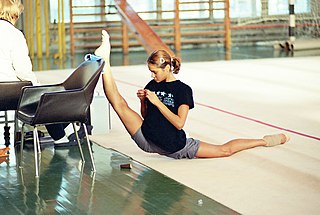
Flexibility is the anatomical range of movement in a joint or series of joints, and length in muscles that cross the joints to induce a bending movement or motion. Flexibility varies between individuals, particularly in terms of differences in muscle length of multi-joint muscles. Flexibility in some joints can be increased to a certain degree by exercise, with stretching a common exercise component to maintain or improve flexibility.
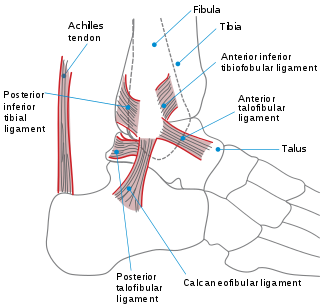
A sprained ankle is an injury where sprain occurs on one or more ligaments of the ankle. It is the most commonly occurring injury in sports, mainly in ball sports such as basketball, volleyball, football, and tennis.

The following outline is provided as an overview of and topical guide to exercise:
Aquatic therapy refers to treatments and exercises performed in water for relaxation, fitness, physical rehabilitation, and other therapeutic benefit. Typically a qualified aquatic therapist gives constant attendance to a person receiving treatment in a heated therapy pool. Aquatic therapy techniques include Ai Chi, Aqua Running, Bad Ragaz Ring Method, Burdenko Method, Halliwick, Watsu, and other aquatic bodywork forms. Therapeutic applications include neurological disorders, spine pain, musculoskeletal pain, postoperative orthopedic rehabilitation, pediatric disabilities, pressure ulcers, and disease conditions, such as osteoporosis.
Eccentric training is a type of strength training that involves using the target muscles to control weight as it moves in a downward motion. This type of training can help build muscle, improve athletic performance, and reduce the risk of injury. An eccentric contraction is the motion of an active muscle while it is lengthening under load. Eccentric training is repetitively doing eccentric muscle contractions. For example, in a biceps curl the action of lowering the dumbbell back down from the lift is the eccentric phase of that exercise – as long as the dumbbell is lowered slowly rather than letting it drop.
Fascia training describes sports activities and movement exercises that attempt to improve the functional properties of the muscular connective tissues in the human body, such as tendons, ligaments, joint capsules and muscular envelopes. Also called fascia, these tissues take part in a body-wide tensional force transmission network and are responsive to training stimulation.

A foam roller is a lightweight, cylindrical tube of compressed foam. It may be used for many reasons, including increasing flexibility, reducing soreness, and eliminating muscle knots. Foam rolling is a method of self-myofascial release. Foam rollers have a short term positive impact in the range of motion of joints, but long term performance or range of motion benefits are unknown. Combining foam rolling and stretching does not cause a significant impact in range of motion compared to only foam rolling or stretching, but does have a superior effect in performance only if stretching is done after foam rolling. A 2021 analysis of studies concluded that "evidence seems to justify the widespread use of foam rolling as a warm-up activity rather than a recovery tool" while arguing that post exercise or recovery rolling reduced muscle pain perception. A 2019 review concluded that 90 seconds of foam rolling per muscle group may be the minimum needed to achieve a reduction in muscle pain or soreness in the short term but that there is insufficient evidence for the optimal amount.
Nerve glide, also known as nerve flossing or nerve stretching, is an exercise that stretches nerves. It facilitates the smooth and regular movement of peripheral nerves in the body. It allows the nerve to glide freely along with the movement of the joint and relax the nerve from compression. Nerve gliding cannot proceed with injuries or inflammations as the nerve is trapped by the tissue surrounding the nerve near the joint. Thus, nerve gliding exercise is widely used in rehabilitation programs and during the post-surgical period.


